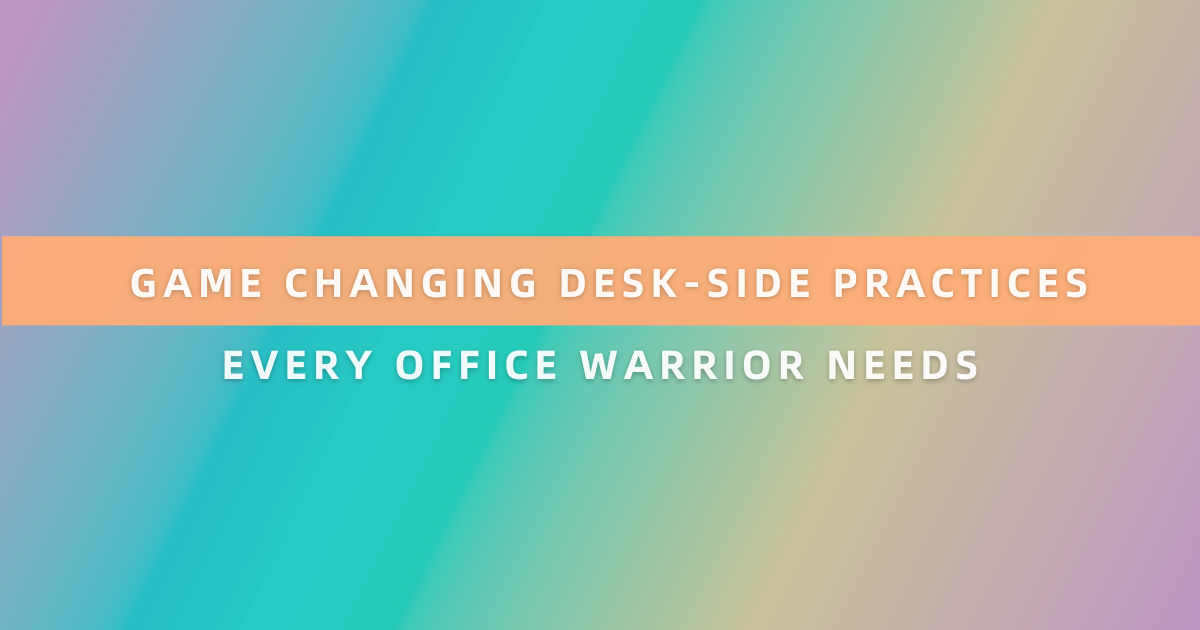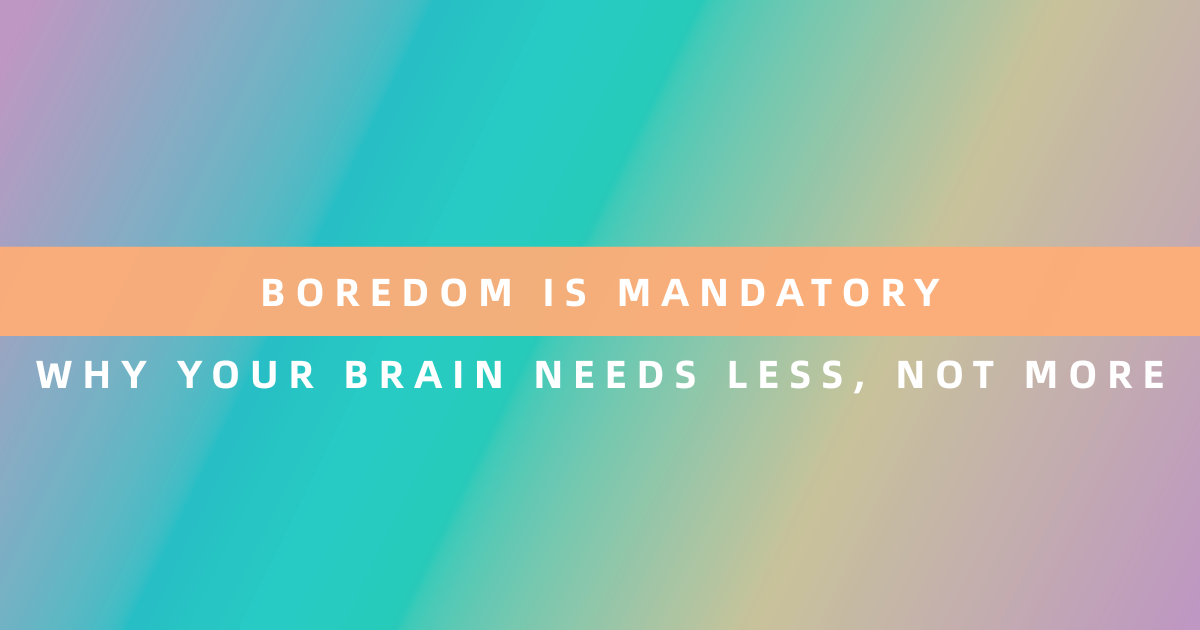Your shoulders ache from hunching over your keyboard, your eyes burn from screen glare, and that third cup of coffee isn’t helping anymore. Meanwhile, your inbox keeps growing, deadlines loom, and you can’t remember the last time you took a real break.
Welcome to the reality of modern office life, where workplace stress costs companies billions in lost productivity and drives talented professionals toward burnout at alarming rates.
The Mental Toll of Modern Office Work
Workplace mental health has reached a crisis point. Recent studies reveal that 76% of employees report at least one symptom of a mental health condition, up from 59% just a few years ago. [1] The culprits? Long hours, constant connectivity, blurred work-life boundaries, and the physical toll of sedentary work.
Many professionals experience a cascade of symptoms that builds throughout the workday. What starts as morning anxiety about pending projects evolves into afternoon brain fog and evening exhaustion. The cycle repeats daily, gradually eroding both performance and well-being.
Physical symptoms compound mental strain. Employees develop chronic neck pain from poor posture, eye strain from endless screen time, and repetitive stress injuries from constant typing. These physical issues create a feedback loop with mental health, where discomfort increases stress, which tightens muscles, which worsens pain.
The traditional response involves expensive ergonomic equipment or occasional wellness workshops. But what if the solution could be simpler? What if small, strategic practices throughout your workday could transform both your productivity and mental health?
Understanding Your Workplace Stress Triggers
Before implementing solutions, identifying your specific stress patterns matters. Common workplace triggers include:
Environmental Factors:
- – Open office noise and distractions
- – Poor lighting or ventilation
- – Uncomfortable seating arrangements
- – Cluttered or disorganized workspace
Digital Overwhelm:
- – Constant email notifications
- – Back-to-back video calls
- – Multiple chat platforms are demanding attention
- – Screen fatigue from prolonged computer use
Workload Challenges:
- – Unrealistic deadlines
- – Unclear priorities
- – Insufficient resources
- – Lack of autonomy
Social Dynamics:
- – Difficult colleagues or managers
- – Isolation in remote work
- – Meeting overload
- – Communication breakdowns
Recognizing these triggers empowers targeted interventions. Rather than receiving general stress management advice, you can develop specific practices tailored to address your unique challenges.
The Science of Micro-Recovery
Research shows that brief, frequent recovery periods throughout the workday significantly impact mental health and performance. These “micro-recoveries” work because they interrupt stress accumulation before it reaches critical levels.
Your nervous system operates in cycles, alternating between sympathetic (stress) and parasympathetic (rest) states. Modern work culture keeps us in a state of sympathetic overdrive. Micro-recovery practices activate the parasympathetic system, allowing brief but essential restoration.
Studies demonstrate that workers who take regular micro-breaks show [2]:
- – 40% better focus and concentration
- – Reduced physical discomfort
- – Lower stress hormone levels
- – Improved creativity and problem-solving
- – Better emotional regulation
The key? These breaks need structure and intention. Scrolling social media doesn’t count as recovery; it often increases stress. Effective micro-recovery requires practices that genuinely restore mental and physical resources.
Essential Deskside Practices for Mental Wellness
The Two-Minute Reset
Every hour, set a gentle reminder for a two-minute reset. This practice involves:
- Posture Check: Roll shoulders back, straighten spine, relax jaw
- Breath Work: Take four deep breaths, extending exhale longer than inhale
- Eye Relief: Look at something 20 feet away for 20 seconds
- Gentle Movement: Neck rolls, wrist circles, ankle flexes
This simple routine counteracts the physical stress of desk work while providing mental clarity. The structured nature prevents the break from becoming another source of distraction.
Strategic Journaling Breaks
Rather than waiting until evening to process work stress, integrate brief journaling moments throughout your day. Digital platforms like Theryo make this particularly effective by providing AI-powered prompts that help identify stress patterns in real time.
Morning journaling might explore:
- – Current energy levels
- – Anticipated challenges
- – One priority that matters most
- – Resources needed for success
Midday check-ins could address:
- – Emotional state shifts
- – Unexpected stressors
- – Small wins to acknowledge
- – Afternoon intentions
End-of-day reflection might include:
- – Accomplishments worth celebrating
- – Lessons learned
- – Tomorrow’s top priority
- – Gratitude for support received
These brief writing exercises, especially when enhanced by AI insights, reveal patterns that help you proactively manage workplace stress.
Mindful Transitions
The moments between tasks offer powerful opportunities for mental health maintenance. Instead of immediately jumping from one project to another, create mindful transitions:
Between Meetings:
- – Stand and stretch for 30 seconds
- – Take three conscious breaths
- – Hydrate mindfully
- – Reset your workspace
After Difficult Conversations:
- – Write down key points to clear mental space
- – Practice self-compassion for any stress experienced
- – Use grounding techniques (notice five things you can see)
- – Set intentions for moving forward
Before High Stakes Tasks:
- – Clear physical and digital clutter
- – Review your purpose and desired outcome
- – Activate positive self-talk
- – Visualize successful completion
Boundary Setting Rituals
Creating clear boundaries between work and rest requires intentional practices:
Morning Activation:
- – Arrive 10 minutes early for personal setup
- – Arrange workspace mindfully
- – Review priorities without email
- – Set a daily wellbeing intention
Lunch Hour Reclaim:
- – Step away from your desk completely
- – Engage in non-work conversation or solitude
- – Move your body, even briefly
- – Practice mindful eating
Evening Shutdown:
- – Create a consistent end-of-day routine
- – Document tomorrow’s priorities
- – Clear desktop (physical and digital)
- – Acknowledge the day’s efforts
Technology as Your Wellness Ally
While technology often contributes to workplace stress, purposeful digital tools can support mental health. Platforms designed specifically for mental wellness transform devices from stressors into supporters.
Theryo’s workplace integration demonstrates this potential. Professionals use the platform to:
- – Track stress patterns across workdays
- – Receive personalized coping strategies based on their unique triggers
- – Share relevant insights with therapists for targeted support
- – Build resilience through consistent micro practices
The AI component identifies when work stress peaks typically occur and suggests preemptive interventions. This proactive approach prevents stress accumulation rather than merely managing symptoms.
Building Your Practice
Creating sustainable deskside wellness practices requires personalization. Start with these steps:
Week 1: Observation
- – Notice current stress patterns
- – Identify your peak stress times
- – Recognize physical tension areas
- – Track energy fluctuations
Week 2: Experimentation
- – Try different micro practices
- – Test various break frequencies
- – Explore breathing techniques
- – Document what resonates
Week 3: Refinement
- – Keep effective practices
- – Adjust timing and duration
- – Combine complementary techniques
- – Build consistent routines
Week 4: Integration
- – Automate reminders
- – Share practices with colleagues
- – Celebrate small improvements
- – Plan for obstacles
Creating a Supportive Work Environment
Individual practices work best within supportive environments. Consider these collaborative approaches:
Team Initiatives:
- – Propose walking meetings for appropriate discussions
- – Suggest standing desk options or stability ball chairs
- – Create quiet zones for focused work
- – Establish meeting-free time blocks
Cultural Shifts:
- – Model healthy break-taking
- – Share wellness wins openly
- – Respect others’ boundary setting
- – Advocate for mental health resources
Physical Improvements:
- – Optimize lighting with desk lamps
- – Add plants for air quality and visual relief
- – Use privacy screens to reduce distractions
- – Invest in ergonomic accessories gradually
Measuring Your Progress
Tracking the impact of deskside practices helps maintain motivation and refine approaches. Monitor:
Subjective Measures:
- – Daily stress levels (1 to 10 scale)
- – Energy patterns throughout the day
- – Sleep quality improvements
- – Overall job satisfaction
Objective Indicators:
- – Productivity metrics that matter to you
- – Sick days or mental health days used
- – Physical symptoms (headaches, back pain)
- – Medication or caffeine dependency
Digital platforms excel at pattern recognition across these measures. Theryo’s analytics, for instance, can correlate specific practices with mood improvements, helping users understand which interventions work best for their unique situation.
Overcoming Common Obstacles
Even with the best intentions, maintaining wellness practices at work presents challenges:
“I’m Too Busy” Reality check: Two-minute breaks improve productivity more than they interrupt it. Start with just one practice daily and build gradually.
“My Workplace Doesn’t Support This.” Begin with invisible practices like breathing exercises or mental check-ins. As you demonstrate improved performance, share your approach with interested colleagues.
“I Forget to Take Breaks.” Use technology wisely. Set gentle reminders, use apps that prompt movement, or pair practices with existing habits like coffee refills.
“I Feel Guilty Stepping Away” Reframe breaks as performance optimization, not laziness. Professional athletes rest between intense efforts; knowledge workers need the same recovery.
Your Next Step
The path from stressed office warrior to thriving professional begins with one small practice. Choose a single technique from this guide that resonates with you. Commit to trying it for one week, tracking how it affects your workday experience.
Consider leveraging technology designed to support workplace mental health. Theryo’s platform offers structured support for building sustainable wellness practices, with AI-powered insights that help you understand your unique stress patterns and most effective interventions.
Whether you start with two-minute breathing breaks or comprehensive digital wellness tracking, remember that small, consistent practices create profound changes over time. Your mental health deserves the same strategic attention you give your work projects.
Transform your desk from a stress zone into a wellness command center. Because when you thrive at work, everyone benefits – your team, your organization, and most importantly, yourself.
Ready to change your workday wellness? Explore how Theryo’s collaborative mental health platform can support your journey from surviving to thriving in the modern workplace.
Frequently Asked Questions
How can I practice wellness at my desk without drawing unwanted attention?
Many effective practices remain invisible to colleagues. Deep breathing exercises, progressive muscle relaxation, and mental check-ins appear like normal desk work. Digital journaling on platforms like Theryo looks identical to regular computer use. Start with subtle practices and gradually incorporate more visible ones as comfort grows.
What if my job genuinely doesn’t allow for regular breaks?
Even in demanding roles, micro practices can fit. Use natural transitions like bathroom breaks or waiting for documents to load. Practice one conscious breath before answering emails. Implement evening recovery routines to counteract daytime stress. Remember that even 30-second practices provide benefits when done consistently.
How do deskside practices relate to professional therapy?
Deskside wellness practices complement but don’t replace professional mental health support. They provide daily maintenance between therapy sessions and create rich material for therapeutic discussions. Platforms like Theryo bridge this gap by helping track workplace stress patterns that therapists can address more effectively.
Can these practices impact serious workplace burnout?
While severe burnout requires comprehensive intervention, including professional support, daily practices prevent escalation and support recovery. Research shows that consistent micro recoveries significantly reduce burnout risk. Combined with therapy and potentially medical support, deskside practices form part of an effective treatment approach.
How long before I notice improvements from these practices?
Some benefits appear immediately, like reduced muscle tension from stretching. Deeper changes in stress resilience and mental clarity typically emerge after two to three weeks of consistent practice. Digital tracking helps identify subtle improvements you might otherwise miss.
What’s the minimum effective dose for workplace wellness practices?
Research suggests that even two minutes of intentional practice every two hours significantly impacts well-being. Start there and expand based on your needs and schedule. Quality matters more than quantity; one mindful minute beats ten distracted ones.
How do I maintain practices during particularly stressful periods?
Stressful times need wellness practices most, yet that’s when we abandon them. Simplify rather than eliminate. Choose one non-negotiable practice, like three breaths before starting work. Use technology for reminders and tracking. Remember that consistency matters more than perfection.
Can workplace wellness practices help with remote work isolation?
Absolutely. Remote workers benefit from structured practices that create boundaries between work and home life. Digital wellness platforms provide connection and accountability. Practices like virtual coffee breaks or shared wellness challenges combat isolation while supporting mental health.
How do I convince my employer to support workplace wellness initiatives?
Present the business case: workplace wellness programs show an average ROI of 3:1 through reduced absenteeism and increased productivity. Start small with personal practices, document improvements, then propose low-cost initiatives like walking meetings or meditation spaces. Focus on performance benefits rather than just wellness.
What role does technology play in workplace mental health?
Technology serves as both a challenge and a solution. While constant connectivity increases stress, purposeful digital tools support wellness. Platforms like Theryo provide structure, tracking, and personalized insights that make workplace mental health practices more effective and sustainable.
How do I know which practices work best for my specific situation?
Experimentation combined with tracking reveals your optimal practices. Try different techniques for at least a week each, monitoring their impact on stress, energy, and productivity. AI-powered platforms can identify patterns and suggest personalized approaches based on your unique responses.







